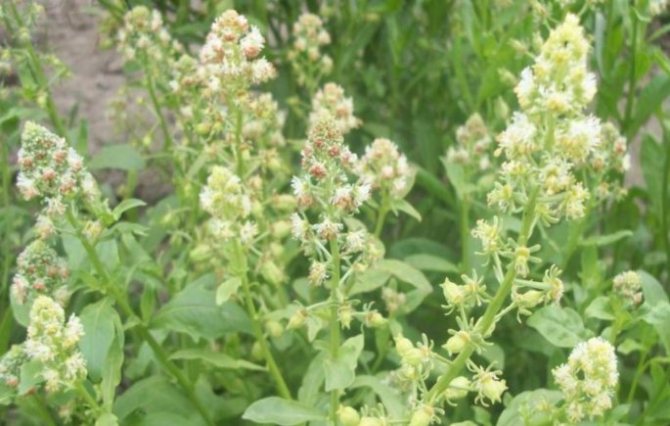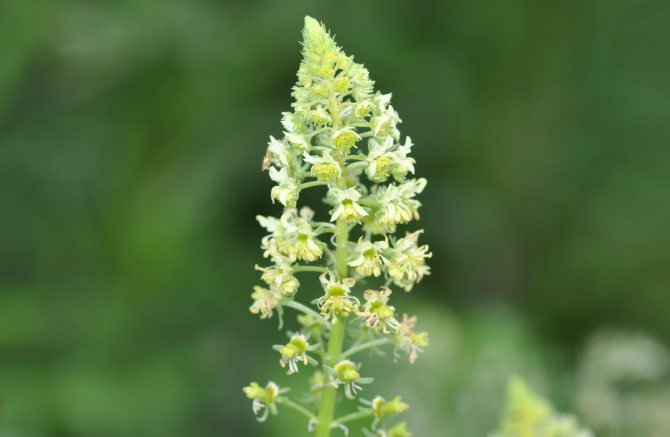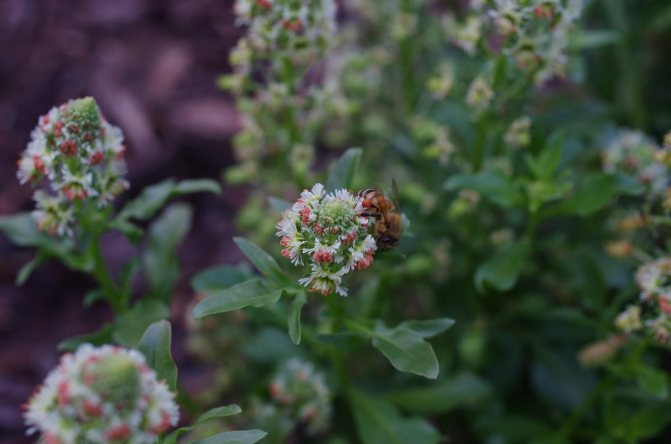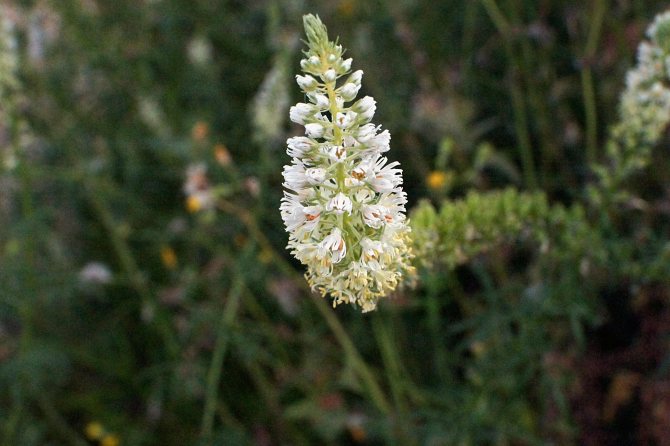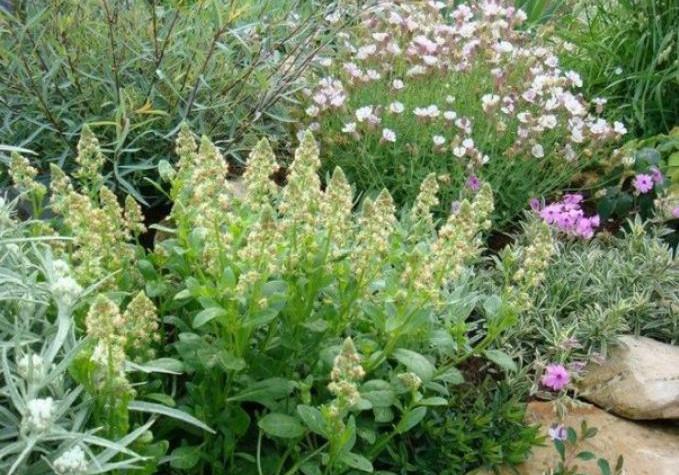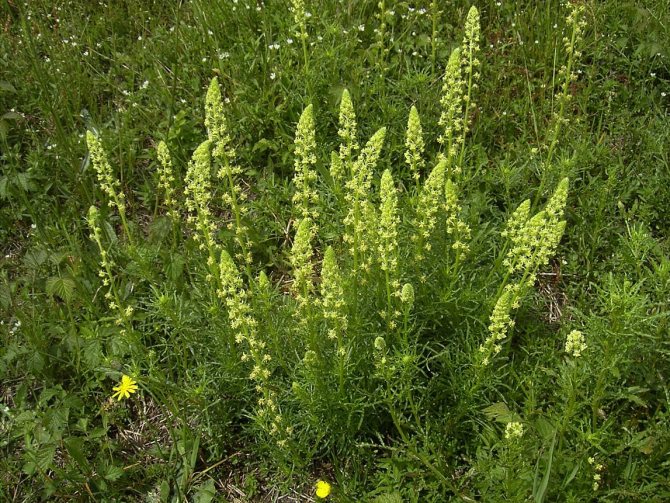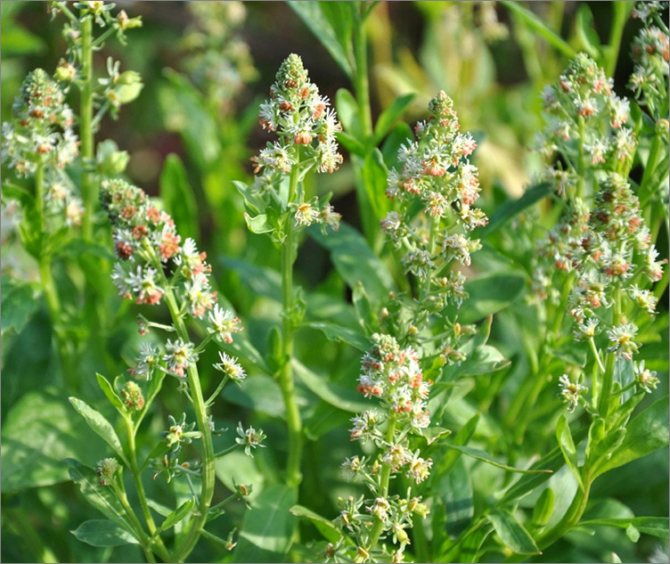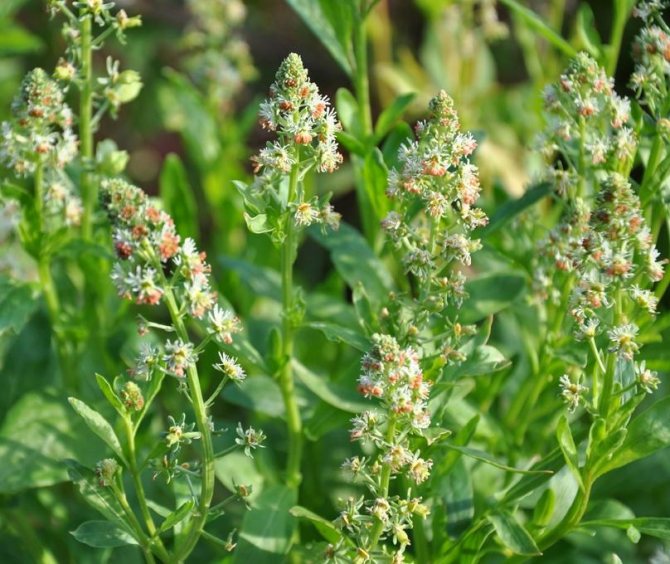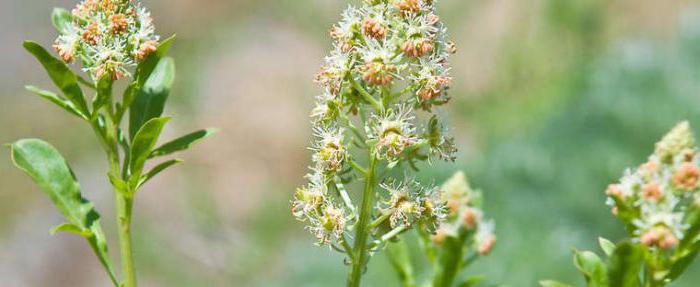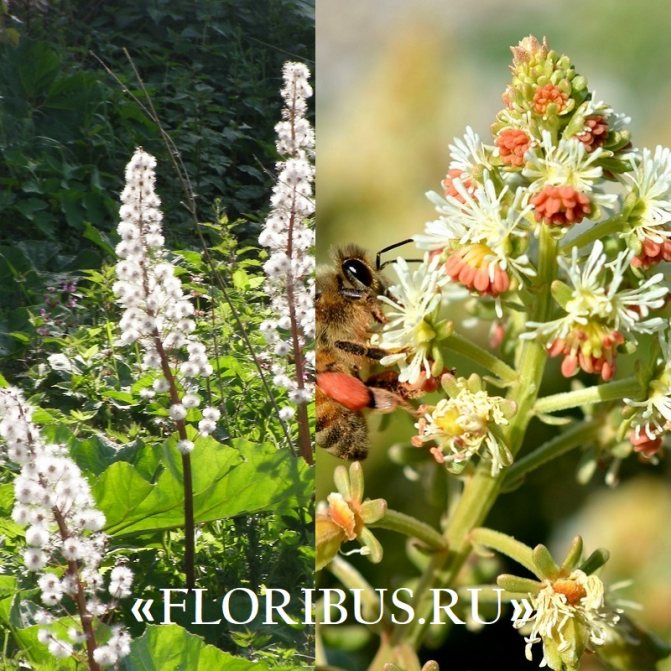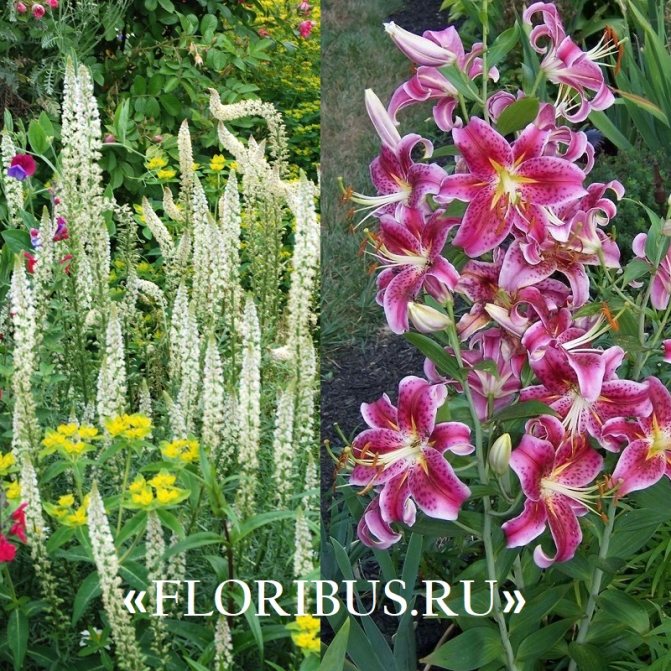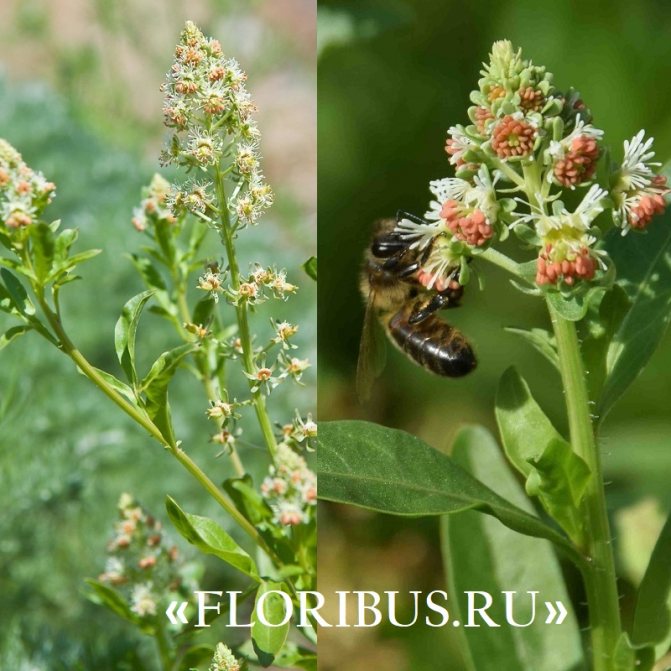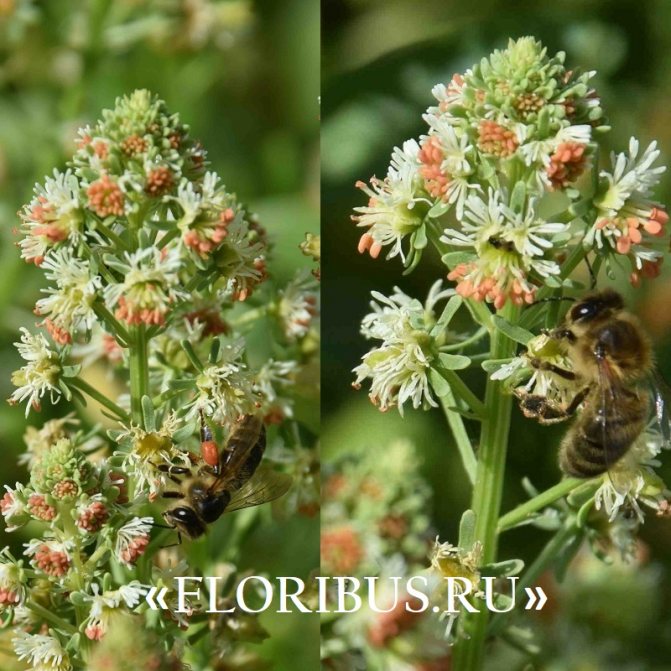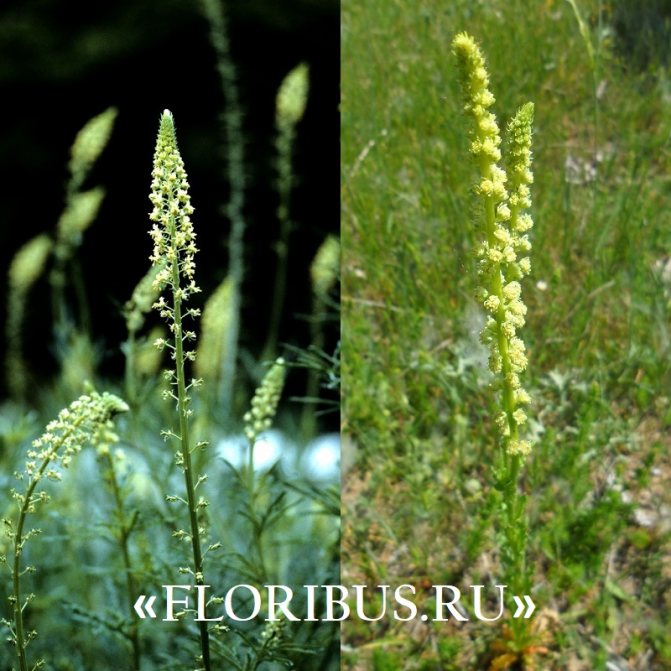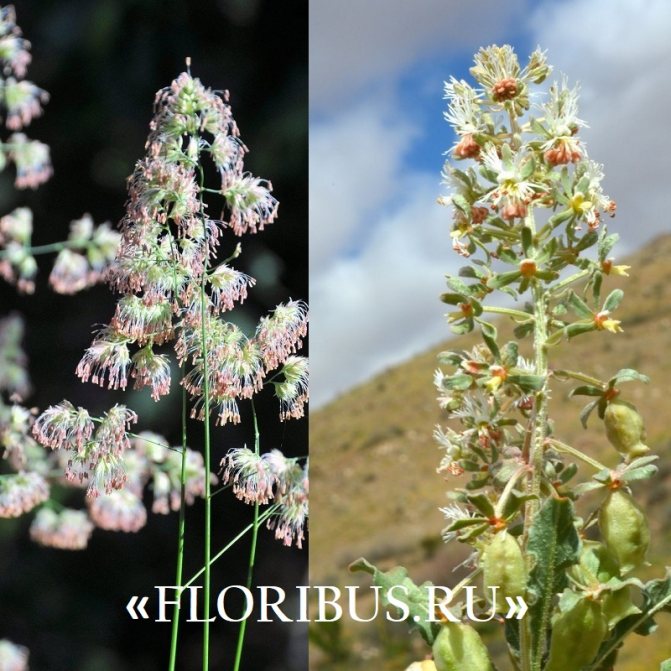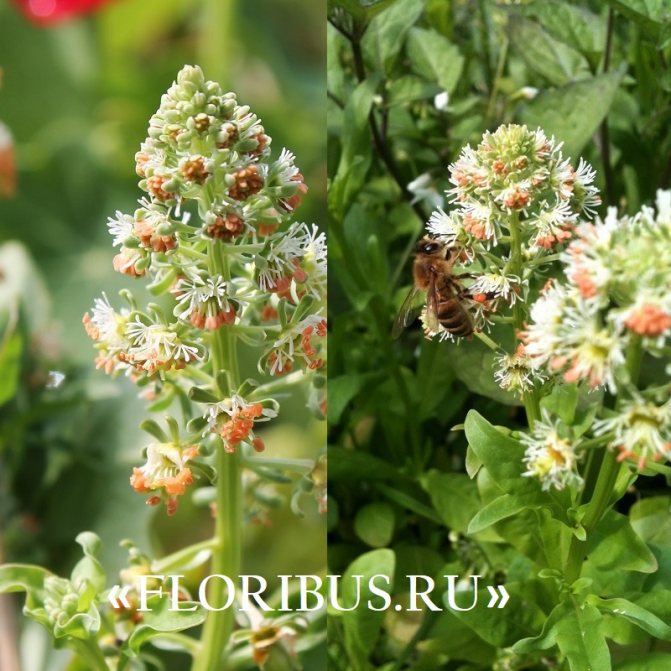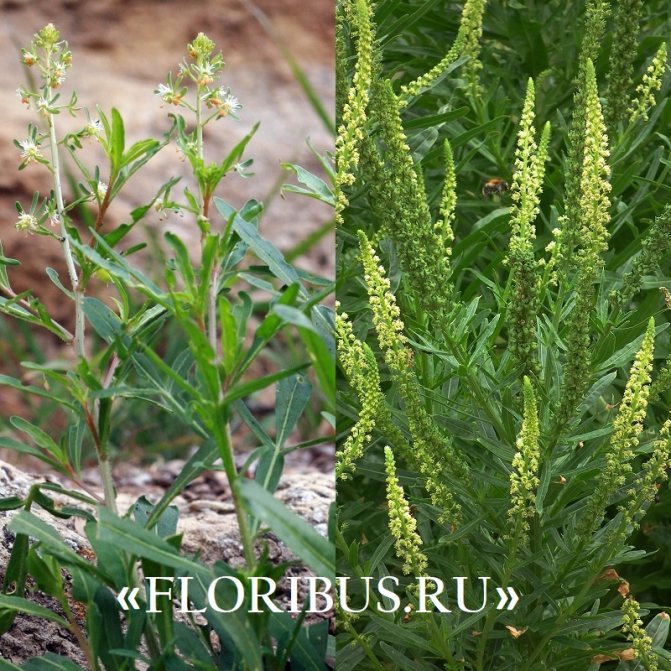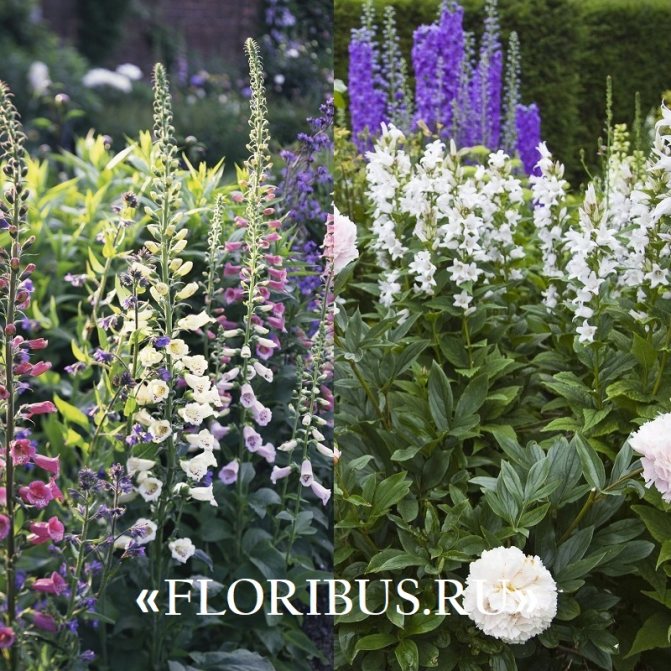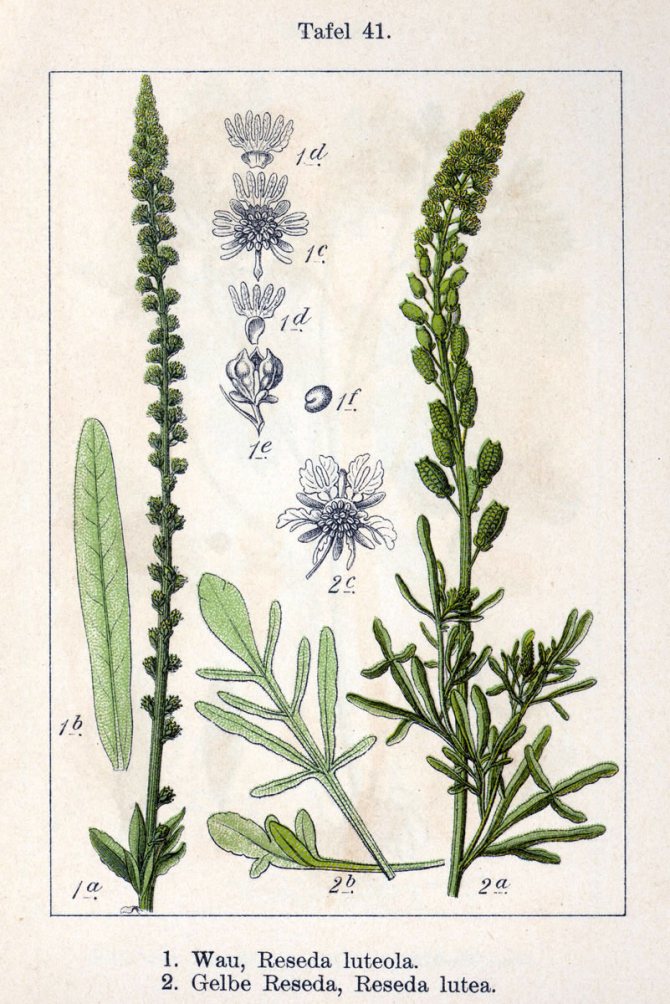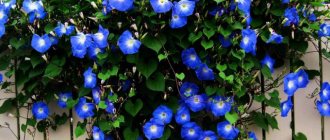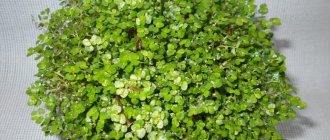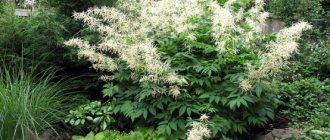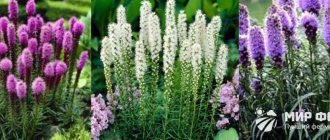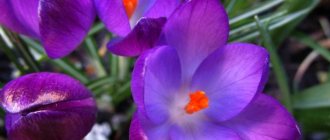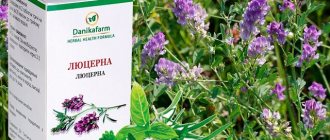Several centuries ago, on any suburban area, there were flower beds with fragrant mignonette. The aroma of this plant spread throughout the district, so at first glance, modest flowers enjoyed unprecedented popularity and were in almost every park or garden. They were used as decorations not only on the table, but also in the wardrobe.
Fragrant mignonette allows you to get rid of migraine attacks, for this you just need to inhale the tart aroma of the flower. No wonder its name is translated as "calm".
Description
The structure of the root system of the plant is pivotal. The aerial part consists of an erect or creeping stem up to 50 cm long with ascending shoots. Leaves are elongated, whole or pinnately-divided with regular arrangement.
It is possible to arrange both types of leaves on one bush. White-yellow or greenish flowers are collected in spike-shaped or racemose apical inflorescences. The flowers are small, star-shaped. In breeding species, flowers are red and orange.
Reseda fruit is a rounded brown box with an open top. During the ripening period, small seeds easily spill out onto the ground, so growers are in a hurry to harvest the fruits early, as soon as they begin to turn yellow. Mature grains of dark color with a steel sheen. Germination is not lost until 4 years.
Fragrant mignonette is a plant, the first mention of which scientists found on the papyri of Ancient Egypt. The healing properties of this flower were used in ancient Rome for the treatment of heart ailments, as well as a diuretic and diaphoretic.
It is no coincidence that sometimes you can find an image of a bottle of perfume on seed bags. So the producers make it clear that many people love this flower for its wonderful aroma, although its pyramidal inflorescences of different colors are charming with a kind of delicate beauty.
Wikipedia about reseda
Ornamental culture - mignonette (lat. Reseda) refers to the genus of herbaceous plants (annuals, biennials, perennials from the mignonette family).
The distribution area of the plant is huge. This includes:
- North Africa;
- Europe;
- partly Asia (reaches India).
An ornamental culture grows up to 20-40 cm. It has spreading ascending branches and fleshy stems, which are formed by a bush - erect or half-lying.
Mignonette blooms from June to October. Interestingly, the color of the inflorescences depends on the shade of the anthers of the stamens, which can be from 10 to 30. The pistils have 3-4 columns. The number of sepals and corolla petals in a flower is the same - 6 pieces each.
The plant is known for its many beneficial properties. It is used in homeopathy and folk medicine, perfumery, beekeeping (high-grade honey is not inferior in quality to linden honey), cooking, and landscape design.
The name of this plant is known to many gardeners, but not everyone can imagine how it looks. But in the photo of the flower beds of the parks of the last century, you can see how well the delicate flowers of fragrant mignonette are combined with orange and red petals of calendula, coreopsis, and graceful zinnia.
Currently, gardening fashion again returns to the landscape the decorative varieties of the mignonette family.Among them: reseda hava fragrant, as well as popular among gardeners, cold-resistant varieties - fragrant red mignonette, fragrant mignonette variety mosque.
It should be noted that this flower culture has been cultivated for centuries and was especially prized for its aroma. Cultivars (varieties) bred for decorative design with a beautiful color of inflorescences do not have such a fragrance as natural mignonette.
Decorative varieties
Reseda Hawskaya fragrant. The height of the decorative annual is about 40 cm. The flowers have a greenish tint, they smell nice. This variety grows well on fertile soils, loves light, does not tolerate waterlogging.
Cultivation is carried out by sowing seeds in the ground (late April - early May) or by seedling. For seedlings, seeds are sown in pots. The emergence of seedlings can be expected in 6-10 days. When transplanting, the roots of the shoots should be in an earthen coma, the interval between plants is from 15 to 20 cm.
Reseda is a fragrant variety of a mosque. Plant height from 20 to 30 cm. Flowers are small with shades of yellowish-green and orange-red anthers. The inflorescences are large. Seeds are sown in the ground in April-May or before winter.
In order for the culture to bloom profusely, it is required to moisten well and enrich the soil with mineral fertilizers. The flowering period is July-September. Landing sites: curbs, flower beds, balconies. And also because of the originality of the flower inflorescence, the plants are used for cutting.
We suggest you familiarize yourself with: The most delicious instant pickled cabbage
The genus Reseda is a representative of the Reseda family, includes 20-30 species. One of them is fragrant mignonette, the most common as an annual culture in our country. Starting the description of fragrant mignonette, it can be noted that even in the last century it was difficult to imagine squares and parks without the scent of wonderful flowers.
The range of the genus is the Northern part of America, Asia (especially India). Many different species are found in the Mediterranean. In warm countries and regions, mignonette fragrant grows as a perennial herbaceous shrub.
The flowers have no decorative value. These are small buds, consisting of 6 corolla petals and the same number of sepals. Inflorescences are racemose, pyramidal in shape. Pale yellow, white or green flowers exude a very bright aroma. Rarely, there are varieties of fragrant mignonette with red buds.
Reseda name matches
The meaning of the letters in the name Reseda:
- P - is present in the name of active, self-confident, independent people, often selfish and not afraid of conflicts;
- E - sociable, sincere, impulsive people, love to talk a lot;
- Z - people with this letter can boast of developed intuition, hardworking, somewhat secretive and sometimes pessimistic about life;
- D - the owners of the name with the letter D are balanced, kind, charming, know how to calculate the situation in advance;
- A - strong, domineering personalities, value comfort, are constantly on the move.
Important years:
- 9;
- 18;
- 27;
- 36;
- 45;
- 54;
- 63;
- 72.

Important life years for Reseda are those that add up to the number nine
Table: name matches
| Planet | Neptune | The ability to create mental images, penetrate the irrational, is responsible for the subconscious and creative talent. |
| Element | Water | Water people are vulnerable, able to adapt to any circumstances, very emotional, have tremendous intuition. |
| Zodiac sign | Fish | Intelligence, gullibility, melancholy. |
| Color | Sea waves | Unwillingness for change, belief in ability, ambition. |
| Metal | Platinum | An ally of calm people, an enemy of gossip and intrigue. Helps to embark on the path of spiritual transformation. |
| A rock | Aquamarine | Symbolizes courage, justice, the ability to recognize deception. Talismans with this stone are good to wear for calming, getting rid of seasickness. Amulet for a happy marriage. |
| Plant | Water lily | Gives flexibility, the ability to adapt to any difficult situations, solve problems with ease. |
| Animal | Dolphin | The totem of a person trying to help others, not afraid of hard work. Such people become excellent family men. |
| Number | 9 | Reputable, fair, demanding, striving for excellence. |
Useful properties of fragrant mignonette
The genus Reseda includes a huge number of plants with useful properties, but it is the fragrant appearance that is most widespread. It is often used to obtain essential oils and has been actively used in herbal medicine since the time of Ancient Egypt.
Today, fragrant mignonette in folk medicine is also widely known as a plant that can lead to a state of mental balance. Essential oil is often used for meditation practices, so the species is widespread in India and other Buddhist countries.
In exotic countries, stems, roots and even leaves of fragrant mignonette are used as a direct flavoring additive to dishes. In perfumery, the aroma of the plant is widely used in the production of elite perfumes and toilet waters.
The plant's melliferous qualities are a useful property for apiary owners. Mignonette produces a lot of nectar and pollen, which attracts small insects. In terms of taste, annual honey is not inferior to linden honey.
When was Reseda born
The character of a girl named Reseda leaves an imprint on the season in which she was born.
- In winter, leaders are born. Reseda, born in the winter months, is ambitious, domineering, independent. She perfectly knows how to control emotions, which is why others often consider her cold and indifferent. Such a woman determines her future herself, not being guided by other people's desires or opinions.
- Spring promotes the birth of people for whom life is eternal movement. "Spring" Reseda strives for self-development, she is an altruist by nature, out of pity for others, she is able to help them to their own detriment. Very vulnerable, a careless remark can upset her to the core.
- Born in the summer, Reseda is absolutely confident, active, and has a good business acumen. Appreciates loyalty and devotion, she herself will never stoop to lies. In a relationship, listen to the partner.
- Sometimes prone to pessimistic thoughts Reseda, born in the autumn season. Often chooses a creative direction of activity, is implemented in the field of art. She likes solitude, thinking about life alone, in any business she tries to get to the bottom of it.


Reseda, born in autumn, loves to reflect on living alone
The signs of the Zodiac, under which the bearers of the beautiful name Reseda were born, also affect their character:
- Aries (march 20 - april 19) Reseda-Aries is distinguished by courage and determination, will always achieve its goal. She moves up the career ladder easily, material well-being is very important for her. Practical, even in relationships with men, she listens to the mind, not feelings.
- Taurus (april 20 - may 20) Reseda, born under the sign of Taurus, is determined and vindictive, breaks ties without regret. It is difficult to create a strong family with such a woman because of her desire for leadership.
- Gemini (may 21 - june 20) The twins endow Reseda with special care, she prefers to play it safe than rush into battle. You can turn to her for advice and support without fear of hearing moralizing. Amorous, but the infatuation passes quickly.
- Cancer (june 21 - july 22) Reseda, born under the sign of Cancer, has an unstable nervous system. Such a woman is prone to increased irritability, impatience. Capricious, difficult to please her, she will always find something to find fault with.
- Leo (july 23 - august 22). Reseda-Leo is a very charismatic, energetic and proud person. Strives for independence, likes to be in the spotlight, often becomes the soul of the company.
- Virgo (august 23 - september 22)Women born under this sign are quick-tempered, but at the same time they do not hold dedication and conscientiousness. The set goal will be achieved diligently and meticulously.
- Libra (september 23 - october 22) Reseda-Libra is easy to communicate, witty, disinterested in friendship. When making a decision, he carefully weighs all the pros and cons, if necessary, he will listen to as many opinions as possible from the outside. In money matters, she is very careful and practical. Cheating and betrayal does not forgive, especially to close people.
- Scorpio (october 23 - november 21). Reseda, who was born under the sign of Scorpio, is not the easiest character. This is a calculating, narcissistic woman. For the sake of profit, she is capable of the most unseemly acts. She chooses a spineless man as her husband, so as not to share the leadership in the family with him and not to reckon with his opinion.
- Sagittarius (november 22 - december 20) Reseda under this sign is enterprising, quick-witted, uncompromising, quick in making decisions. Any business will be completed. Difficulty admitting his mistakes.
- Capricorn (december 21 - january 19) Reseda, born under the sign of Capricorn, is very patient, she is not afraid of troubles. Independent, secretive, keeps the most intimate thoughts to herself, not trusting even close people. A devoted wife will always take the side of her husband.
- Aquarius (january 20 - february 17) Reseda-Aquarius is stubborn and unbalanced, but seeks to control herself. She is not afraid of difficulties, makes decisions instantly, but haste plays a cruel joke with her - such decisions are often wrong. With difficulty forgives offenses, despises the weak, generosity is not her trait.
- Pisces (february 18 - march 19) A woman under this sign is very impressionable, suspicious, believes in prejudices. Failures unsettle her for a long time. Reseda-Pisces is often envious, annoyed when others achieve success where she could not prove herself. Likes to complain about the fate of loved ones.


Reseda, born under the zodiac sign of Pisces, is very suspicious and believes in prejudice
Popular types
On the territory of Russia, two types of plants are most common: mignonette white and fragrant.
Fragrant mignonette
Fragrant mignonette (Reseda odorata) is the most common fragrant annual crop. The habitat of the plant covers the North American continent, the Mediterranean, the countries of Asia and especially India.
Fleshy stem with spreading, lateral processes forms a pyramidal bush 20-40 cm high. Ascending, erect processes are leafy.
The shape of the leaves is small, elongated. The surface of the leaves is leathery, barely wrinkled. Color coloration varies from light to rich green, depending on the lighting conditions.
The completely unattractive flowers have small buds of 6 corolla petals and 6 sepals. Pyramidal, dense racemes are white, pale yellow or green. Their main charm is a rich aroma.
There is a mignonette flower with red flowers, as in the photo.
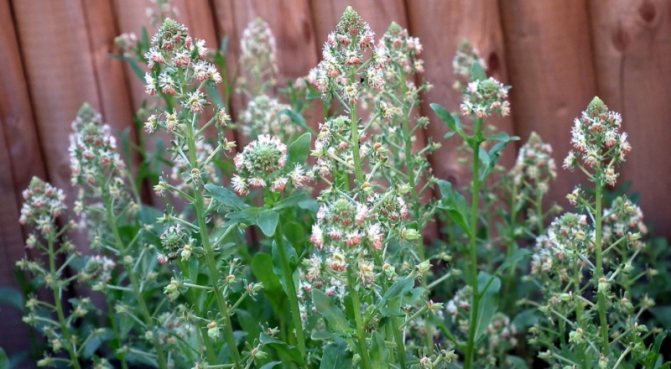

Among the garden forms that have earned the recognition of flower growers, the following varieties of fragrant mignonette stand out:
- Ambergris - is an old variety, the inflorescences of which have a bright aroma and notes of sweetness. The smell is more intense in the late afternoon. An adult bush grows 40-45 cm.
- Khavskaya has strong, ascending stems of medium foliage. A bush up to 45 cm high forms about 9 root shoots. A powerful peduncle bears a vertical brush of 23 cm. It blooms 2 months after sowing in the ground.
- The red machete is a small plant 30 cm high. During the flowering period, it is covered with large flowers.
- Victoria with beautiful scarlet and brown inflorescences.
Reseda white
White mignonette (Reseda alba) is considered a tall annual with erect processes 0.5-1 m tall. The bush has a decorative shape with clear contours. The top of the bush is decorated with large, white tassels.
We offer you to read: Secrets of how to grow large onions
Yellow
Perennial common in the European part of Russia. Tall stems are covered with split leaves. Inflorescences are painted in a sunny greenish tone.
Cultivation of fragrant mignonette from seeds (with photo)
Reseda is cultivated more often for the production of essential oils for perfumery and medicinal raw materials.
For growth, a flower needs a moist, fertile soil with neutral acidity and the presence of lime in the composition. Slightly alkaline loams are suitable. Heavy soils are improved with perlite, peat, sand. Dolomite flour is used to reduce acidity. It is necessary to provide drainage so that waterlogging does not lead to root rot.
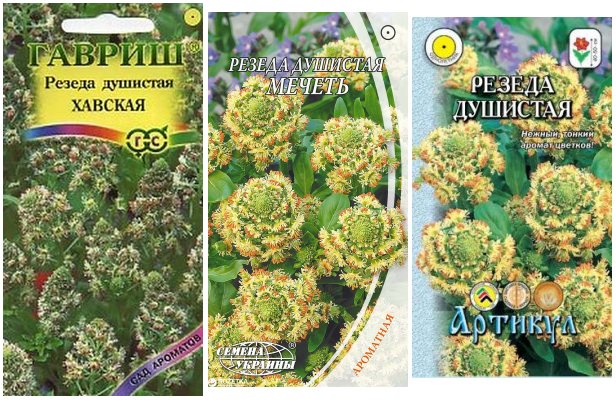

The plant loves lighted places and tolerates partial shade well. Differs in cold resistance. In the summer, you will need abundant watering, loosening row spacings and removing weeds.
To get a lush flowering will help carrying out systematic fertilizing with a complex composition of mineral fertilizers. Container and greenhouse plants are fed every 10-14 days, flower beds - after 3 weeks. Flowering is also facilitated by the regular removal of dry inflorescences.
Reproduction of mignonette is carried out by seeds. And in order to grow healthy plants, there is a set of rules, adhering to which you will be able to get a good result:
- In open ground, seeds are sown in rows in the 2nd and 3rd decades of April, measuring a distance of 40-50 cm between them.
- You need to sow 1-2 pieces at intervals of 1 cm, on top of the seeds 2-3 cm must be sprinkled with sand (so that a crust does not form after the rain).
- Before sprouting, the soil must be watered with a watering can. The first shoots appear after 7-14 days. As they grow, the flower bed is thinned out. As a result, a free space of 20 cm should form between the plants.
If the seeds are sown in early spring, and then in the second half of it, then the garden will be filled with the scent of mignonette all summer long.
To obtain early flowering, the seeds of the plant must be sown for seedlings in pots (boxes) with a mixture of turf, humus earth and sand in a ratio of 1: 1: 0.5. The seeds are left on the surface, lightly sprinkling them with soil.
This method can be chosen by those who really want to grow fragrant flowers on their balcony. Photos illustrating the cultivation of seedlings will help to correctly perform the necessary steps for planting and caring for flower seedlings:
- 3-4 seeds are sown in each pot.
- After the emergence of seedlings, when they grow up to 3-5 cm, they need to be thinned out. Usually two more developed shoots are left.
- In order for the mignonette bushes to be correctly formed and bloom profusely, the tops of the seedlings are pinched over the 3rd or 4th pair of leaves.
To harden the plants, pots with seedlings are placed on the balcony in good weather.
Mid-May is the best time to plant outdoors. Before this, the planting site must be fertilized with compost.
After the work done, about 2.5 months will pass and the young mignonette will thank you with abundant flowering.
Caring for a flower culture is simple:
- in the summer, the aisles are weeded and loosened;
- plants are watered abundantly;
- wilted inflorescences are removed, this allows you to preserve the decorative effect of mignonette bushes and ensures the duration of flowering;
- the introduction of complex mineral fertilizers is carried out 2 times - the period from the first appearance of the buds to the end of the flowering of the mignonette.
You can buy varieties with your favorite shade of inflorescences in flower shops, in markets, in an online store. The most popular are the red-green flowers of the Red Monarch variety, the luxurious yellowish-reddish branches of the Masheta, the bright scarlet Goliath and others. The price of fragrant mignonette seeds by varieties:
- Hawskaya: for 0.2 g - 12 rubles;
- Romance: for 1 g - 28 rubles;
- White night: for 1 g - 19 rubles;
- Perfume: for 0.5 g - 30 rubles.
Reproduction and planting of fragrant mignonette in a personal plot does not require special knowledge, physical conditions and attention from the gardener. Cultivation of fragrant mignonette is possible by sowing seedlings and in open ground. The end result will be the same.
Like any other annual culture, the fragrant mignonette is propagated with the help of seeds. A vegetative method of reproduction is simply not required, since with the onset of frost, the culture will simply freeze. Annual garden varieties delight with fragrant inflorescences for only one season, often even in the southern regions.
We suggest you familiarize yourself with: Growing tomato seedlings in a city apartment
In order for the mignonette to feel as comfortable as possible, you will need fatty soil, it can be loam or soil with a high lime content. Stagnant moisture and waterlogging can lead to the death of mignonette. In the pits, you can lay a good drainage layer of broken brick, fine gravel or sand.
You can start sowing planting material for growing fragrant mignonette from seeds in early spring - March, early April. Fragrant mignonette has a very weak root system, which does not tolerate frequent transplants.
Therefore, it is best to choose separate containers for seedlings - cups or peat tablets. Picks can be avoided by sowing seeds directly into open ground. This can be done at the end of spring, as the frost recedes. The distance between crops must be at least 20 cm.
Seedlings of fragrant mignonette can be planted in a "snail" from a substrate for the laminate. This method will ensure the maintenance of a peculiar microclimate and facilitate the work of planting seedlings in open ground. Reseda sprouted at home blooms several weeks faster, but the result, namely aroma and abundance of growth, does not depend on the method of cultivation.
Name characteristic
Pierre Rouget, a French explorer, described a woman named Reseda as freedom-loving, independent, self-confident. The bearers of this name are very objective, concrete, with a strong will, they have a quick reaction, but they keep themselves in control, do not let emotions escape, are highly moral, looking for an excuse for the mistakes of other people, but they do not forgive themselves. They can be realized in any professional field.
Boris Higir also notes Reseda's strong character. Frank and honest, she always expresses her opinion, can find a way out of any situation thanks to her analytical mindset, does not trust her intuition, rationally calculates everything. Reseda is a wonderful keeper of the hearth, a loving and faithful wife, a caring mother. Family comes first for her.
Childhood cutting
Already in the character of little Reseda, her main feature is manifested - accuracy, the girl loves very much that every thing is in its place. When playing with other children, Redochka will never stain or tear clothes. If parents started cleaning at home, Reseda will immediately come to their aid.


Little Reseda is very neat and will always help her mother with household chores
Already at a young age, Reseda is distinguished by justice and honesty, prefers clarity in everything. For the teenage Reseda, the father becomes the authority, she seeks to imitate him. There are a lot of friends near the charming and kind Reseda. The girl constantly deals with their problems, which is why she cannot resolve her own. Straightforward Reseda does not tolerate intrigues, scandals, she will always stop gossip about someone.
Adult woman
Reseda is a very reasonable, punctual and persistent person. Strong qualities - intelligence, rationalism, hard work, the desire to improve life - help her achieve what she wants. Sometimes she is too stubborn and tactless, which creates difficulties in communicating with people. In some cases, benevolent Reseda can show vindictiveness if injustice affects people close to her.


Reseda is very hardworking and persistent in achieving her goals.
Reseda and career
It is very important for Reseda to do what she loves, only in this case she will build a career and move up the career ladder. Having not decided on a profession to her liking, a woman will often change specialties. However, in any case, she will behave like a responsible employee, she knows how to present interesting and useful ideas, she is respected in the team. Reseda rarely turns out to be a businesswoman, but the scope of activities suitable for her is very wide. The owner of this name can be realized in the following professions:
- chemist;
- translator;
- cosmetologist;
- restorer;
- stewardess;
- kindergartener;
- teacher;
- pediatrician;
- the hairdresser;
- costume designer;
- actress.


The field of activity in which Reseda can succeed is very wide, for example, the profession of a stewardess is suitable for her
Reseda knows the account of money, she always has an amount set aside for a "rainy day".
Health
Reseda is naturally healthy. Chronic diseases are not about her. A woman with this name goes to doctors very rarely, coping with ailments on her own.
Love and marriage
Reseda is a romantic and amorous girl. She easily forgets the object of sympathy, if he does not share her feelings, and goes in search of reciprocity. Starting a family has been a goal for Reseda since childhood, so the girl often gets married early. She is a wonderful hostess, she always has perfect order. Stocky, practical - it brings everything into the house. The owner of the name Reseda is a wonderful mother, she adores children, and is happy to babysit the kids. Repeated marriages for Reseda are a huge rarity, since she seeks to save the family by any means, even if the spouses have relationship problems. In most cases, Reseda is able to save a marriage.


Family for Reseda always comes first, she is a loving wife and caring mother
Table: compatibility with male names
| Names | Features of relationships |
| Alexander | Alexander and Reseda are able to become a harmonious couple, but for this they both have to make an effort. For Alexander, Reseda corresponds to the idea of an ideal woman. She reciprocates with a man only when she is completely sure of her feelings for him. Despite the love between partners, financial difficulties can make their family life very difficult. If the spouses do not find a way to solve this problem, scandals cannot be avoided. |
| Alexei | Alexey is not the one who Reseda needs for a love relationship. Determined and serious, looking for a man for marriage, she scares off Alexei, who is inclined to a fleeting affair. A marriage union between them is possible only under duress. |
| Andrew | Between Reseda and Andrei, mutual understanding very rarely arises. It is not possible for them to create a harmonious couple, a man and a woman with these names speak different languages and do not understand each other. |
| Albert | Albert and Reseda have similar ideas about the ideal family. Albert values loved ones, he is a loving and attentive husband, a caring father. Reseda feels support in him, is confident in the future. However, Albert, like Reseda, is obsessed with order, on this basis they may quarrel, since each spouse seeks to do as he thinks is right. |
| Marseilles | There are no seething passions in the relationship between Marcel and Reseda, they are based on mutual understanding and respect. They are able to listen to the opinion of a partner, solve complex problems together. Marcel and Reseda's marriage is strong and durable. |
| Dmitriy | Reseda and Dmitry can create a strong love union. The housekeeper Dmitry suits Reseda, who is striving for home comfort. Their family life is filled with happiness and peace. The marriage between this man and woman can be called ideal. |
| Evgeny | Reseda knows how to inspire Eugene, he is able to make her happy. The woman appreciates Evgeny's honesty, the man likes her serious attitude towards the family.Such a couple often marry, but they need a clear separation of duties in order to avoid quarrels. |
| Marat | Reseda is approached by the prudent and pragmatic Marat. They think and live on the same wavelength, they perfectly understand each other. As for Reseda, for Marat, the main thing in life is family, he is happy to help his wife with household chores and raising children. |
| Sergey | Sergei's unpredictability scares off the judicious Reseda. She does not see this man as a reliable companion, he is annoyed by his partner's straightforwardness. A slight flirtation is possible between them, after which both will go in search of more suitable options. |
| Timur | Timur is very jealous and suspicious. Reseda will have to spend a lot of effort to convince a partner of loyalty. If Timur learns to trust her, then the marriage will be a fortress, the man will do everything for the family. Otherwise, Reseda, tired of making excuses, will break the bond that humiliates her. |
| Edward | Edward lacks sensuality in a relationship. Even for Reseda, who knows how to hide emotions, the partner seems cold. It is difficult for a man to convince a woman that he is not using her for profit. As a result, Reseda deletes Edward from life, the novel ends with nothing. |


The marriage between Albert and Reseda will bring them happiness
Seedlings in the open field
After sowing seeds in seedling containers, the first shoots appear in about a week. You can plant seedlings in open ground after the appearance of 2-3 true leaves, in mid-May. In regions with colder climatic conditions, it is better to start replanting seedlings in early summer - early June.
An excellent "neighbor" for this culture will be the malcolmia flower, which can set off it and create an amazing carpet around small bushes.
How to care for a plant
Reseda is an unpretentious plant. Requires regular watering and keeping the soil loose. Weeding is mandatory at the beginning of the development of the bushes. Top dressing is done for earlier and more intense flowering, but is not required.
Remove faded flowers. This will preserve the aesthetic appearance of the plant and stimulate the growth of new flowers.
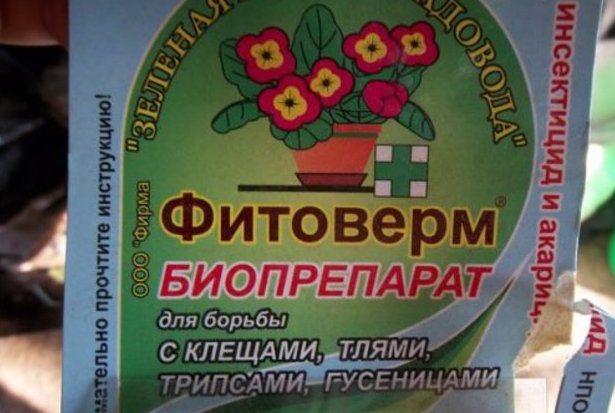

The plant is not sick. Rarely affected by pests. The danger is posed by white-haired caterpillars, against which insecticides can be used ("Kinmiks", "Fitoverm").
Reseda in garden decoration
Reseda is suitable for growing in flower beds, in the garden and on the balcony. The plant is planted as a curb near the terrace. Planting mignonette near the house, along the path or next to the gazebo will allow you to fully enjoy the luxurious scent.
Companion plants are considered annuals with red and orange flowers, such as marigolds, salvia, zinnia, calceolaria. Hybrid varieties with large peduncles of red, copper, white look good in single, garden plantings. They rarely smell.
Neighborhoods with other fragrant plants, such as levkoy, should be avoided. The flower grows well as a pot culture and is used for spring forcing.
Medicinal use
Reseda is an excellent honey plant. In terms of taste and rich aroma, honey is not inferior to linden honey.
The flower also has medicinal properties. This is evidenced by the very name of the flower "resedae", which in Latin means to calm, heal. The healers of Ancient Egypt and Rome already used mignonette. The essential oil of the plant is capable of restoring peace of mind.
In herbal medicine, mignonette is known as a diuretic, diaphoretic and pain reliever. Infusion of the herb helps with heart disease. Reseda is used for colds and fevers, the broth is drunk for stone diseases. In the East, mignonette is a flavoring condiment. All parts of the plant and the root are suitable for this.
Tags: grow, flowerbed, mignonette
About
«Previous post
Recommended species and varieties
R. lutea (R. yellow)
In mid-late summer forms short thin brushes of small (no more than 6 mm in diameter) almost odorless yellowish-green flowers. The stem is weakly branched, with green leaves up to 15 cm long. Their plate is generally lanceolate, deeply dissected along the edge. A short-lived perennial, often behaving like a biennial. The height and diameter of the plant is 30x15 cm.
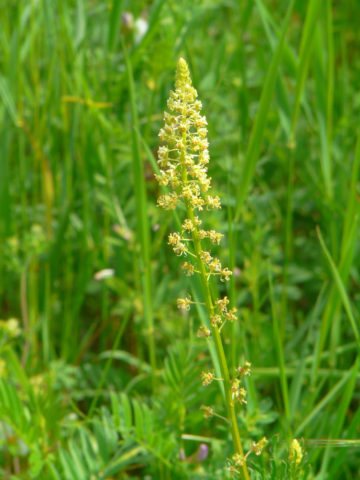

Short thin brushes of small flowers
Luteola (R. yellow, R. dye)
Thin erect apical brushes of this species reach a length of 60 cm. Sometimes small lateral brushes extend from their base. Greenish yellow or white flowers only 5 mm in diameter bloom in the second half of summer. A powerful biennial with green lanceolate leaves up to 10 cm long wavy at the edges.The height and diameter of the plant is 90x45 cm.
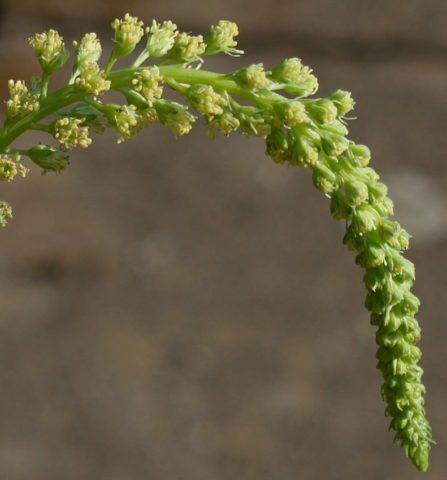

Thin erect apical brushes
R. odorata (R. fragrant)
From mid-summer to autumn, it forms conical clusters of very fragrant light yellow or light green flowers with petals no more than 5 mm long, which are surrounded by bright orange-brown stamens. Oval green leaves up to 10 cm long. Fast growing annual with directional lateral shoots. The height and diameter of the plant is 45x30 cm.
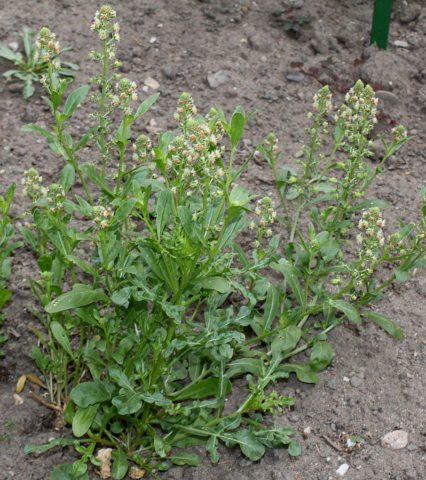

Conical brushes
Growing conditions
The site for planting reseda should be well-lit by the sun, although it tolerates partial shade quite well. Insufficient lighting does not affect the development of the plant, but it can lead to a loss of compactness of the shrubs and weaken the smell of mignonette during the flowering period. The soil is necessary, enriched with slightly alkaline loams, to which sand, expanded clay, peat are added. If the soil is acidic, then gardeners recommend adding dolomite flour or lime. When growing mignonette in pots, use a clay soil mixture with the addition of peat.
Landing
It is better to choose an open and sunny place for planting, but not very hot, although mignonette can grow in partial shade. The soil is preferable sufficiently fertile, therefore, it is advisable to fertilize the site with well-processed compost.
Garden soil with an alkaline reaction is perfect. Acidic soils need to be limed by adding wood ash or lime. It grows poorly on heavy soils. You can improve the soil by adding a small amount of sand, peat, perlite. Good drainage plays an important role, since plants do not tolerate stagnant water and waterlogging.
A distance of 10-20 cm is left between the flowers, depending on the variety and size of an adult bush.
Advice! In sunny areas, mignonette blooms more abundantly and smells stronger. In shady areas, the plant stretches, and the bush falls apart and loses its decorative effect.
How does it multiply?
The crop is usually propagated by seed. They are planted in open ground from half of April. Seedlings are planted in May. To get seedlings in March, the seeds must be sown in boxes. In the open field, the distance between crops should be about 50 cm.
After the emergence of seedlings, they must be thinned out. The distance between shoots should be about 15 cm. The soil should be constantly loose. In addition, weeds must be removed.
Since the seeds fall off very easily, the seed pods must be cut off immediately after they turn yellow. They then ripen in places where there is little sunlight.
Growing and caring for mignonette
Reseda is a light-loving and cold-resistant plant. Prefers fertile, non-acidic soils with a high lime content. Delivers partial shade.
Mignonette is propagated by seeds, which are sown in March in pots or in open soil in April-May.
To make the flowering more dense, it is necessary to remove wilted inflorescences. With the seedling method of growing, keep in mind that the seedlings do not tolerate transplanting well without a clod of earth, and then they get sick for a long time.
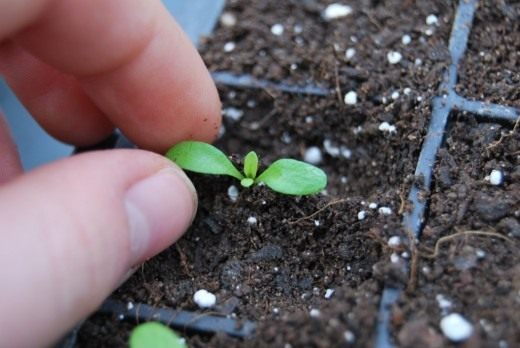

Seedling of mignonette.
Personal experience on video
About growing mignonette at home - in the blog "Visiting Elena".
Perennial climbing plants for the gazebo
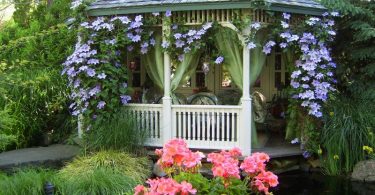

Enegolovnik "Blue Star" and others: photo, planting, care
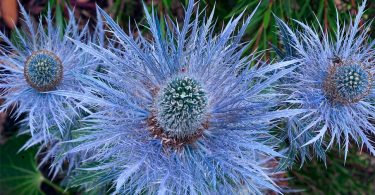

[collapse]
Reproduction
Reseda is bred by sowing seeds in open ground with the arrival of April-May or early spring for seedlings. Growing seedlings is carried out in containers or in a greenhouse.
In a garden plot for seeds, rows are prepared at a distance of 40 cm and a depth of 5 cm. In them, the seed is placed 1 cm after each other. The grooves are covered with sand or earth in a layer of 3 cm. The use of sand will prevent the formation of a crust after watering or rains. Before sprouting, sprinkle gently with a garden watering can to avoid washing the seeds. Shoots appear on the 10-14th day. Seedlings 3-5 cm high are thinned out. Leave a gap of 15 cm between the stems in the garden.
When transferring seedlings from pots, which occurs at the end of May, it is necessary to preserve the integrity of the earthen coma so as not to injure the fragile roots. Otherwise, the plant takes root for a long time.
Secret meaning
At birth, we are given a name that will accompany us throughout our lives. And even after his death, the person's name remains on his memorial. It is logical that the name determines our life, is reflected in the character and behavior. Many scientists, philosophers and astrologers are trying to decipher the mystery of male and female names. Over the years, new proper names appear, while the old ones fade into oblivion. In ancient times, babies were called so to ward off evil spirits, not to offend the gods. In fact, the choice of a name is limited only by the scope of imagination. So, what does the name Reseda conceal?


His origin is Tatar, although it is believed that there are Latin, Spanish and French roots. In his youth, the character of Reseda can be ambiguous, which manifests itself in inconsistency and lack of logic. Such a girl is overly altruistic, but in achieving a personal goal she can show selfishness. Her secret lies in true femininity, without masculine traits. That is, Reseda is never rude, vulgar and grumpy. She is a true lady, sexy, hot, but very correct and loyal.
Reseda flower - features of growing at their summer cottage
In this article you will find everything about how to grow a mignonette flower in a summer cottage. Features of planting, care, the most popular varieties and applications.
More recently, one could find mignonette in every front garden.
This flower has long been considered a migraine deliverer.
Thanks to its wonderful aroma, one could get rid of headaches by walking in the summer garden, inhaling its aroma.
This unpretentious plant takes root in almost any garden.
More than 50 different species have been bred.
It is because of the smell that this culture is still respected.
Mignonette is unpretentious, she only needs sunlight and abundant watering.
This flower is used as a medicine, as a decoration, and as a bait for bees.
Reseda flower - description of the plant
Culture blooms all summer.
From the beginning of June until the onset of cold weather.
Due to its wonderful aroma, it is an excellent honey plant.
In every flower bed, where there is a flower, you can watch how the bees choose to pollinate it.
The flowers are small and inconspicuous, and the seeds ripen in capsules that open only after ripening.
The height of the plant, depending on the variety, is 30-60 cm.
Fragrant mignonette is very often used in perfumery as a raw material.
Often you can see the image of a perfume bottle on the seed bags.
She belongs to the genus of annuals.
Small white flowers with a light green tint smell sweet all summer.
Popular varieties of mignonette
The range includes a large number of species that bloom all summer.
There are several of the most popular varieties. Let's consider them in more detail:
- Fragrant mignonette. Its stem reaches a height of 50 cm. The bush is erect and spreading.The odorous culture looks very nondescript and faded, but its wonderful aroma spreads over long distances.
- Red Monarch is a herb used in folk medicine as a pain reliever for headaches, migraines and cerebral vasospasm. Red Monarch is a low bushy plant, not exceeding 30 cm in height. It emits a wonderful aroma. Flowers are collected in greenish inflorescences. Red Monarch blooms in the same way as fragrant from the beginning of June until the onset of the first frost.
- Ruby is an ornamental variety. Quite a pretty plant, the flowers of which are white interspersed with a ruby hue. Stunted - up to 30 cm in height. Very unpretentious and easy to grow. Ruby can often be found grown on a balcony or windowsill. Ruby has a wonderful sweet scent. It can also be seen in the decoration of front gardens, alpine hills and flower beds.
- Fragrant Red is a very popular variety. Small flowers are collected in rather large inflorescences. Like most varieties, Red Fragrant Mignonette has a lovely sweet scent all summer long. It is used as an ornamental plant in the decoration of borders. The leaves are oblong. It is thermophilic and does not like frost.
- Red-pink mignonette is another popular plant in gardeners' front gardens. Elongated, oblong, pyramidal-shaped flowers of red-pink color will decorate any garden and front garden. The flowers are surprisingly compact, they are not spreading, but erect. Plant height does not exceed 50 cm. Flowering begins in late June and ends in late September - early October. Mignonette is frost-resistant, but also enjoys sunny, open areas and lots of moisture. It has a pleasant aroma, and it is this quality that gardeners often use as a trick to lure bees to their flower garden.
Features of growing mignonette
Reseda is a rather unpretentious plant.
She loves a sunny open surface with abundant moisture.
In the shade, it will also take root, but the aroma will not smell so much during the flowering period and the flowers will become even smaller than they really are.
Not all types of mignonette are suitable for decorating flower beds and flower beds. Therefore, before starting to grow this plant, you should decide for what purpose to grow it.
- If for the spread of a pleasant aroma and attracting bees for pollination, then the most common type is suitable for this purpose - Fragrant mignonette.
- And if for decorating and forming compositions in front gardens and flower beds, then such a look as Ruby or Reseda red-pink is quite suitable. They, in addition to bringing a wonderful copper and ruby tint to the combination of colors, will also add a sophisticated sweetish smell.
Although mignonette is not capricious, but if there is a strong desire to help her in flowering, then for the speedy and better survival of the plant in the chosen sunny place, the top layer of the soil should be loosened.
This will improve moisture absorption.
During hot and dry days, mignonette should be watered more often. Timely removal of wilted flowers will speed up the appearance of new ones.
For feeding the plant, such mineral fertilizers are suitable as:
- potash;
- phosphoric;
- nitrogen;
- microfertilizers.
Reproduction of mignonette occurs mainly by seeds.
In mid-April, it is already possible to plant in open ground, and in closed ground, planting should be carried out in March. To get seedlings, seeds should be planted in special garden containers.
Seedlings will appear in two weeks.
After the appearance of the first pairs of leaves, the plant must be dived into the ground or into peat pots, which can then be planted directly into the ground without removing the plant from them.
Then it will serve as a good humus for him.
The transplant must be carried out carefully, because the taproot is very susceptible to it.
You need to pinch the leaves that have appeared above the third pair of true leaves in order for the flowering to be more abundant.
Seedlings are planted at a distance of 15-20 cm from each other, so that in the future they do not interfere with each other and look very organic together.
Seeds are also sown at a distance of 15-20 cm from each other, covered with a small layer of earth and spilled. It is advisable to water it every day, but make sure that the water does not stagnate. Stagnant water will provoke seed rot.
The mignonette flower is a unique plant. It is charming and empathetic. Many people know about her aroma firsthand.
Therefore, be sure to grow this wonderful honey plant and a beautiful garden for you !!!
Save the article to your favorite social network so as not to lose:
mister-
Growing and caring for mignonette
Reseda is a light-loving and cold-resistant plant. Prefers fertile, non-acidic soils with a high lime content. Delivers partial shade.
Mignonette is propagated by seeds, which are sown in March in pots or in open soil in April-May.
To make the flowering more dense, it is necessary to remove wilted inflorescences. With the seedling method of growing, keep in mind that the seedlings do not tolerate transplanting well without a clod of earth, and then they get sick for a long time.
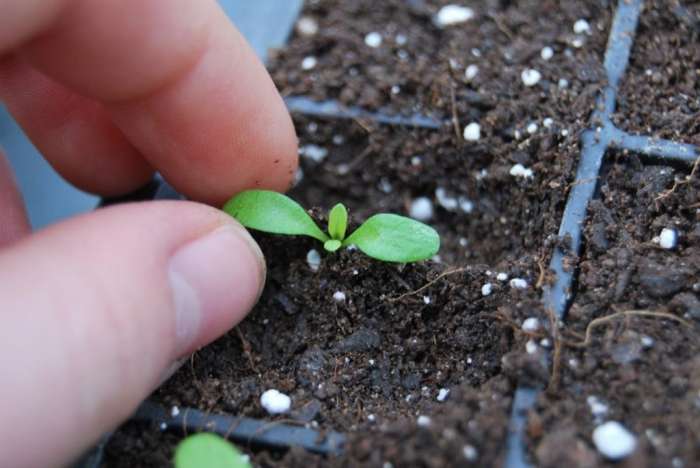

Seedling of mignonette.
How to apply in landscaping?
This ornamental plant in landscape design is appreciated for the beautiful shape of the leaves and unsurpassed aroma flowers.
This culture is used in flower beds and flower beds. She decorates the borders. They are planted on terraces and balconies. Very often, gardeners sow the plant near benches and gazebos in order to smell the aroma while relaxing. Annuals that can become partners of fragrant mignonette:
- Zinnias;
- Salvia;
- Marigold.
Using
The medicinal properties of the plant have been known since ancient times: even in ancient Rome, mignonette was used to treat heart disorders, as well as as a diuretic.
From the roots of the river. yellow in the 1st millennium BC received a yellow dye artsiku for dyeing textiles.
The plant has been used for these purposes for a long time and in our time, until synthetic paints appeared. Now only silk fabrics are dyed with it.
Due to its pleasant aroma, mignonette is popular in decorative landscaping of areas. It is planted along paths, in rabatkas, near gazebos and benches, and decorated with borders and balconies. In the cut form it lasts a long time, therefore it often turns out to be a component of bouquets, giving them a charming delicate scent.
Where to buy seeds?
Fragrant mignonette seeds can be purchased at almost all gardening stores, markets and online stores.
Care activities
Caring for the culture is not particularly difficult: the plant needs to be watered regularly and abundantly, but in no case should it be poured, this can lead to decay.
A perennial fragrant plant is very often grown in Russian gardens. In not very cold winters, it feels calm under the snow cover. To prevent the plant from freezing, do not remove wilted shoots and leaves before winter. The leaves on the back have a silvery color, which attracts the attention of flower lovers.
Top dressing also works well. Mineral fertilizers act as top dressing. It is advisable to feed it 2 times a week.
This culture practically does not suffer from diseases. But pests often affect the culture. Among the pests, caterpillars of white butterflies are often found.
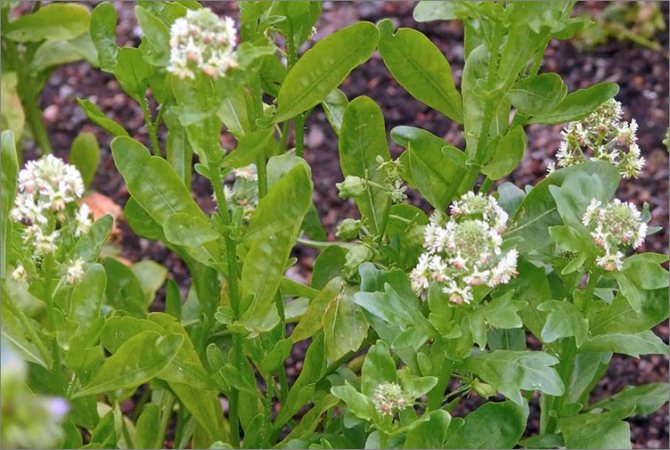

Combination of hair and clothing color.
When choosing clothes, do not be guided only by your taste or fashion trends, take into account your skin tone and hair shade. Let's take a look at color combinations according to hair color.
Blonde hair


Blondes are better off avoiding colors that will overwhelm their natural palette. If you still want to use bright colors when creating an image, then you need to choose the right shade of it.
Dark hair


Bright and saturated colors are great for brunettes. Pastel colors need to be chosen very carefully so as not to get a faded, tired look. Choose white or gray rather than beige. Pay attention to the shade of your hair: warm or cold - you need to choose a beige or gray outfit in accordance with it.
Red hair


A striking appearance requires more care in color selection. Stylists advise drawing attention to the hair, both with the help of contrasting colors and with clothes to match the hair. Red is a warm color and is difficult to combine with other saturated colors.
Ash hair


Girls with ashy hair can wear both bright colors and clothes to match the hair, which will emphasize the silvery play.
Color matching rules.
To look stylish and trendy, you need to follow a few rules. Using them you can achieve an attractive appearance.
For example, if in creating your image you preferred one color, then it must be diluted with something, it is better to use bright, contrasting accessories.
The three-color rule states that no more than three colors can be combined in clothes. If your image has more than three colors, then your image turns out to be overloaded and can irritate people around you.



